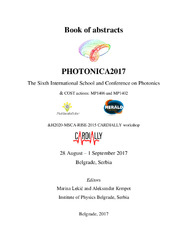Приказ основних података о документу
Laser ablation of nickel/palladium multilayer thin films by nanosecond pulses
| dc.creator | Salatić, Branislav | |
| dc.creator | Petrović, Suzana | |
| dc.creator | Bogdanović-Radović, Iva | |
| dc.creator | Čekada, M. | |
| dc.creator | Panjan, P. | |
| dc.creator | Pantelić, D. | |
| dc.creator | Jelenković, B. | |
| dc.creator | Peruško, Davor | |
| dc.date.accessioned | 2023-05-10T09:08:48Z | |
| dc.date.available | 2023-05-10T09:08:48Z | |
| dc.date.issued | 2017 | |
| dc.identifier.isbn | 978-86-82441-46-5 | |
| dc.identifier.uri | https://vinar.vin.bg.ac.rs/handle/123456789/10944 | |
| dc.description.abstract | Metallic thin films, based on nickel (Ni) and palladium (Pd)are promising material for a wide range of application, as catalytic components [1], optical devices [2], photovoltaic gas sensors [3], dye sensitized solar cells [4], and especially for environmental purposes [5]. The potential of nanosecond laser micro-processing for surface modification of nickel-palladium (Ni/Pd) multilayer thin film deposited on n-type (100) silicon wafer was studied. The multilayer structure composed of five bilayer (Pd/Ni) was deposited by d.c.sputtering from a pure Ni and Pd targets, using Ar ions, to a total thickness of about 180 nm. These multilayer thin films were then exposed to various number of pulses of Er:Glass laser, operating at 1540 nm wavelength with pulse duration of 44 ns. Multi-pulse laser irradiations were done at an incidence angle of 90 in an ambient air environment. The changes of the composition and surface morphology in the 5x(Pd/Ni)/Si system were monitored by Particle Induced X-Ray Emission (PIXE), by Rutherford backscattering spectrometry (RBS), by scanning electron microscopy (SEM) and by profilometry. The main part of the absorbed laser energy was rapidly transformed into heat, producing intensive modifications of composition and morphology on the multilayer surface. The results show an increase in surface roughness, formation of a specific surface topography, appearance of hydrodynamic features and ablation of surface material without shallow or deep crater like characteristics. RBS analysis revealed that laser modification was induced intermixing between the individual Ni and Pd layers, but also with silicon substrate. During the laser processing of 5x(Pd/Ni)/Si system delivered energy was probably sufficient to cause solid-state reactions, the formation of intermetallic compounds and silicides with Ni and Pd. An interesting finding is the 5x(Pd/Ni)/Si thin film has undergone some changes in the chemical composition and structure in the irradiated areas, indicating better crystallinity with an increase of the number of applied pulses. | en |
| dc.language.iso | en | |
| dc.publisher | Belgrade : Institute of Physics Belgrade | |
| dc.rights | openAccess | |
| dc.source | PHOTONICA2017 : 6th International School and Conference on Photonics and COST actions: MP1406 and MP1402 : Program and the book of abstracts | |
| dc.title | Laser ablation of nickel/palladium multilayer thin films by nanosecond pulses | en |
| dc.type | conferenceObject | |
| dc.rights.license | ARR | |
| dc.citation.spage | 173 | |
| dc.description.other | VI International School and Conference on Photonics and COST actions: MP1406 and MP1402 : PHOTONICA2017 : August 23 - September 1, 2017; Belgrade. | |
| dc.type.version | publishedVersion | |
| dc.identifier.fulltext | http://vinar.vin.bg.ac.rs/bitstream/id/29218/PHOTONICA2017-5.pdf | |
| dc.identifier.rcub | https://hdl.handle.net/21.15107/rcub_vinar_10944 |
Документи
Овај документ се појављује у следећим колекцијама
-
040 - Laboratorija za atomsku fiziku
Department of Atomics Physics -
Radovi istraživača
Researchers' publications

